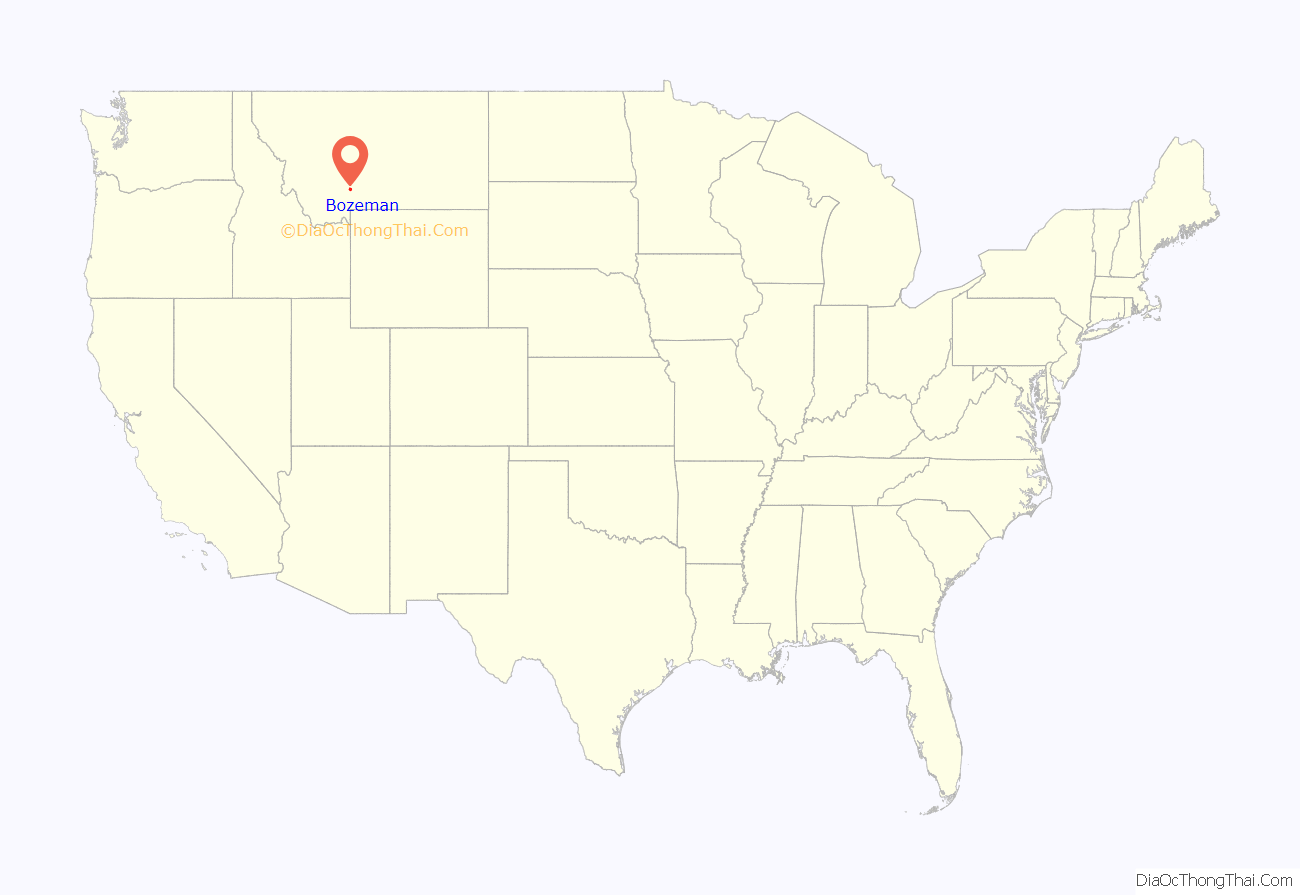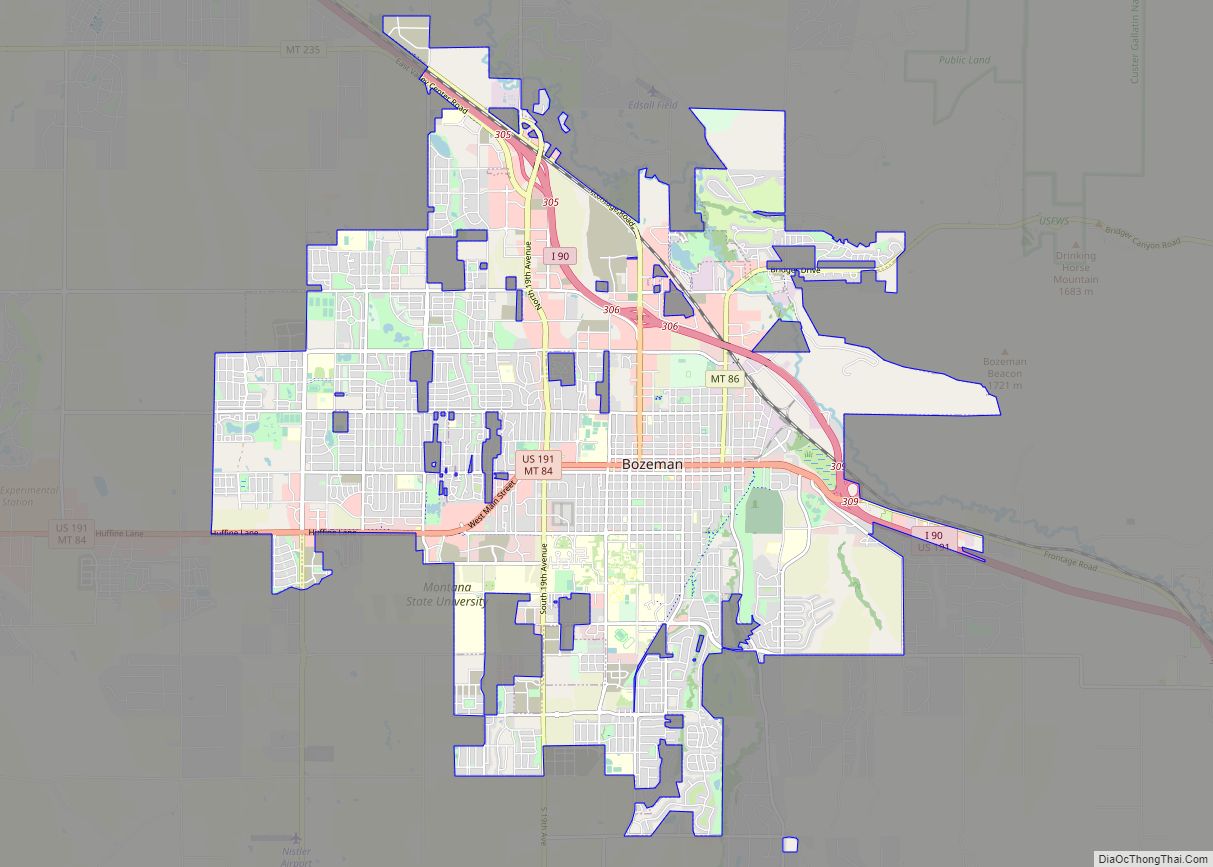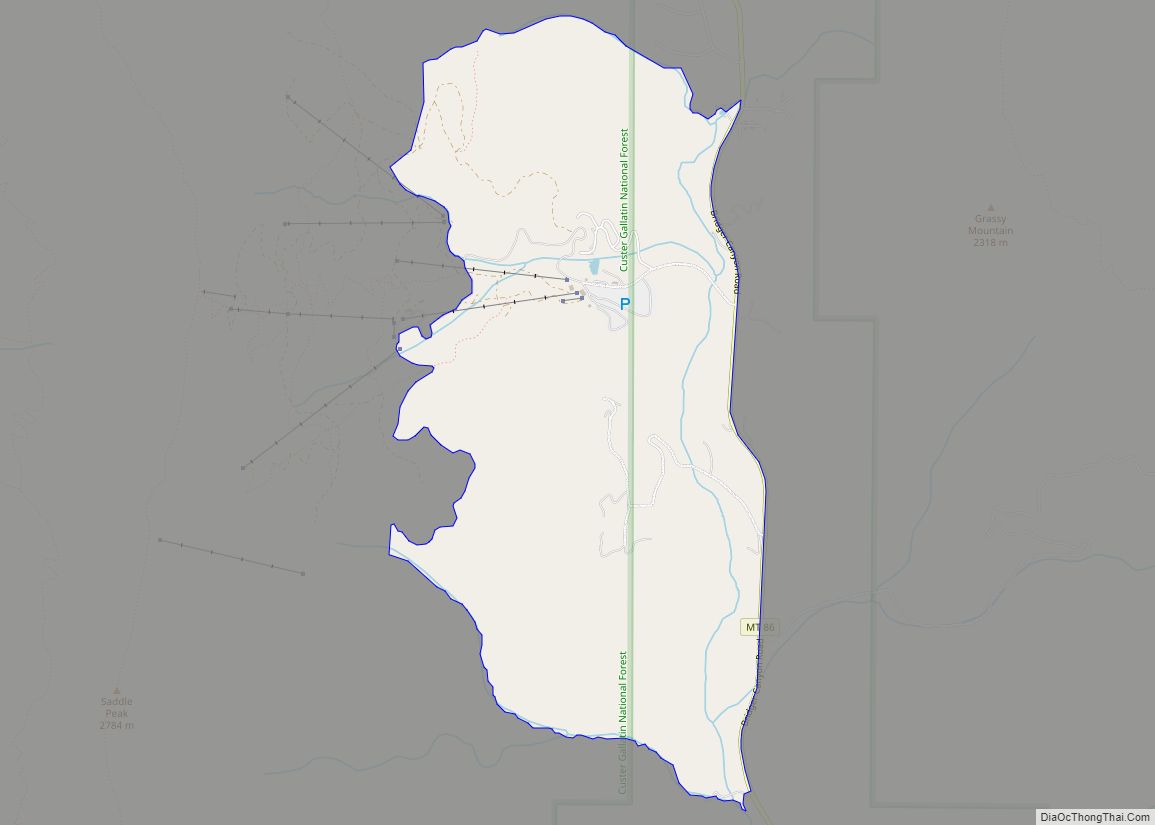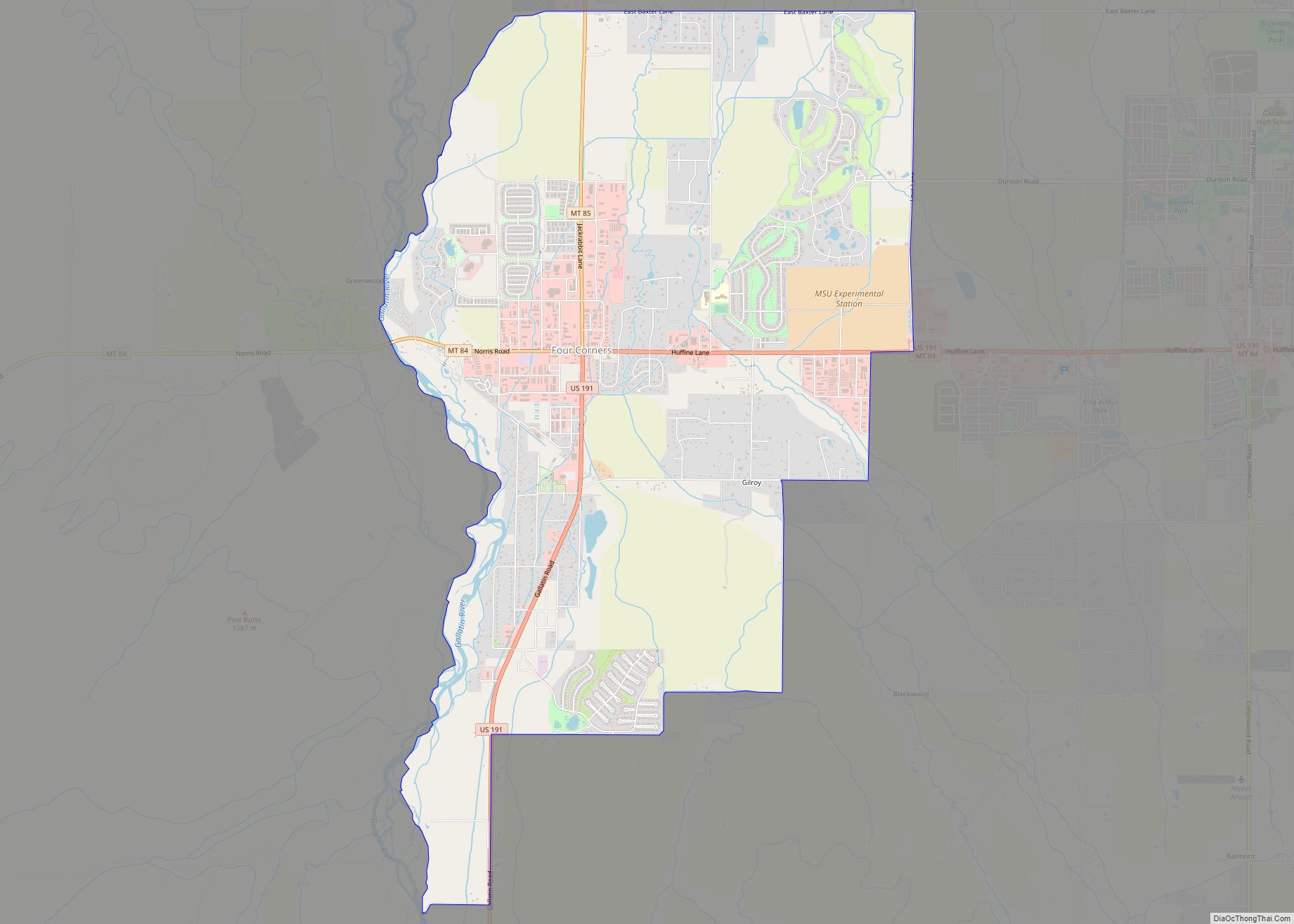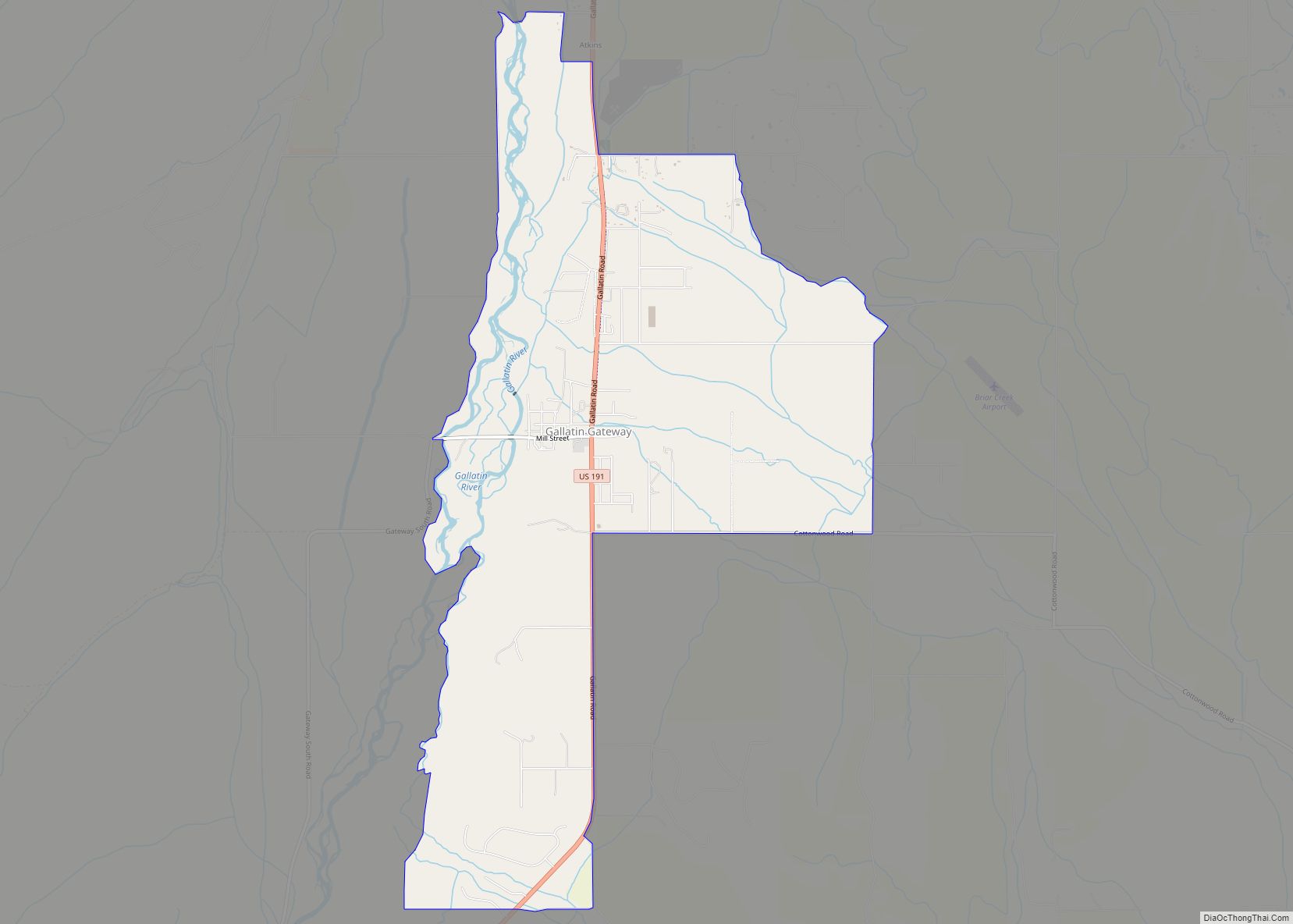Bozeman (/ˈboʊzmən/ BOHZ-mən) is a city and the county seat of Gallatin County, Montana, United States. Located in southwest Montana, the 2020 census put Bozeman’s population at 53,293 making it the fourth-largest city in Montana. It is the principal city of the Bozeman, MT Micropolitan Statistical Area, consisting of all of Gallatin County with a population of 118,960. It is the largest micropolitan statistical area in Montana, the fastest growing micropolitan statistical area in the United States in 2018, 2019 and 2020, as well as the second-largest of all Montana’s statistical areas.
| Name: | Bozeman city |
|---|---|
| LSAD Code: | 25 |
| LSAD Description: | city (suffix) |
| State: | Montana |
| County: | Gallatin County |
| FIPS code: | 3008950 |
Online Interactive Map
Click on ![]() to view map in "full screen" mode.
to view map in "full screen" mode.
Bozeman location map. Where is Bozeman city?
History
Early history
For many years, indigenous people of the United States, including the Shoshone, Nez Perce, Blackfeet, Flathead, Crow Nation and Sioux traveled through the area, called the “Valley of the Flowers”. The Gallatin Valley in particular, in which Bozeman is located, was primarily within the territory of the Crow people.
19th century
William Clark visited the area in July 1806 as he traveled east from Three Forks along the Gallatin River. The party camped 3 miles (4.8 km) east of what is now Bozeman, at the mouth of Kelly Canyon. The journal entries from Clark’s party briefly describe the future city’s location.
In 1863, John Bozeman, along with a partner named John Jacob, opened the Bozeman Trail, a new northern trail off the Oregon Trail leading to the mining town of Virginia City through the Gallatin Valley and the future location of the city of Bozeman.
John Bozeman, with Daniel Rouse and William Beall, platted the town in August 1864, stating “standing right in the gate of the mountains ready to swallow up all tenderfeet that would reach the territory from the east, with their golden fleeces to be taken care of.” Red Cloud’s War closed the Bozeman Trail in 1868, but the town’s fertile land still attracted permanent settlers.
In 1866, Nelson Story, a successful Virginia City, Montana, gold miner originally from Ohio, entered the cattle business. Story braved the hostile Bozeman Trail to successfully drive some 1,000 head of longhorn cattle into Paradise Valley just east of Bozeman. Eluding the U.S. Army, who tried to turn Story back to protect the drive from hostile Indians, Story’s cattle formed one of the earliest significant herds in Montana’s cattle industry. Story established a sizable ranch in the Paradise Valley and holdings in the Gallatin Valley. He later donated land to the state for the establishment of Montana State University.
Fort Ellis 45°39′16″N 110°56′35″W / 45.65444°N 110.94306°W / 45.65444; -110.94306 (Fort Ellis), el. 4,987 feet (1,520 m) was established in 1867 by Captain R. S. LaMotte and two companies of the 2nd Cavalry, after the murder of John Bozeman near the mouth of Mission Creek on Yellowstone River 45°42′52″N 110°23′20″W / 45.71444°N 110.38889°W / 45.71444; -110.38889 (Mission Creek), and considerable political disturbance in the area led local settlers and miners to feel a need for added protection. The fort, named for Gettysburg casualty Colonel Augustus Van Horne Ellis, was decommissioned in 1886 and few remnants are left at the actual site, now occupied by the Fort Ellis Experimental Station of Montana State University. In addition to Fort Ellis, a short-lived fort, Fort Elizabeth Meagher (also simply known as Fort Meagher), was established in 1867 by volunteer militiamen. This fort was located eight miles (13 km) east of town on Rocky Creek.45°38′30″N 110°55′05″W / 45.64167°N 110.91806°W / 45.64167; -110.91806 (Fort Elizabeth Meagher), el. 5,249 feet (1,600 m)
Other
In 1864, W.W. described Gallatin County as “one of the most beautiful and picturesque valleys the eye ever beheld, abounding in springs of clear water.” Many tended to agree, and Bozeman quickly garnered the nickname of “The Egypt” of Montana.
After incorporation, the first issue of the weekly Avant Courier newspaper, the precursor of today’s Bozeman Chronicle, was published in Bozeman on September 13, 1871.
Bozeman’s main cemetery, Sunset Hills Cemetery, was given to the city in 1872 when the English lawyer and philanthropist William Henry Blackmore purchased the land after his wife Mary Blackmore died of pneumonia in Bozeman in July 1872.
The first library in Bozeman was formed by the Young Men’s Library Association in a room above a drugstore in 1872. It later moved to the mayor’s office and was taken over by the city in 1890. The first Grange meeting in Montana Territory was held in Bozeman in 1873. The Northern Pacific Railway reached Bozeman from the east in 1883. By 1900, Bozeman’s population had reached 3,500.
In 1892, the United States Commission of Fish and Fisheries established a fish hatchery on Bridger Creek at the entrance to Bridger Canyon. The fourth oldest fish hatchery in the United States, the facility ceased to be primarily a hatchery in 1966 and became the U.S. Fish and Wildlife Service’s Bozeman National Fish Hatchery, later a fish technology and fish health center. The Center receives approximately 5,000 visitors a year observing biologists working on diet testing, feed manufacturing technology, fish diseases, brood stock development and improvement of water quality.
Bozeman was home to early minor league baseball. In 1892, Bozeman fielded a team in the Class B level Montana State League. In 1909, the Bozeman Irrigators played as members of the Class D level Inter-Mountain League. Both leagues disbanded.
Montana State University was established in 1893 as the state’s land-grant college, then named the Agricultural College of the State of Montana. By the 1920s, the institution was known as Montana State College, and in 1965 it became Montana State University.
20th century
Bozeman’s first high school, the Gallatin Valley High School, was built on West Main Street in 1902. Later known as Willson School, named for notable Bozeman architect Fred Fielding Willson, son of Lester S. Willson, the building still stands today and functions as administrative offices for the Bozeman School District.
In the early 20th century, over 17,000 acres (69 km) of the Gallatin Valley were planted in edible peas harvested for both canning and seed. By the 1920s, canneries in the Bozeman area were major producers of canned peas, and at one point Bozeman produced approximately 75% of all seed peas in the United States. The area was once known as the “Sweet Pea capital of the nation” referencing the prolific edible pea crop. To promote the area and celebrate its prosperity, local business owners began a “Sweet Pea Carnival” that included a parade and queen contest. The annual event lasted from 1906 to 1916. Promoters used the inedible but fragrant and colorful sweet pea flower as an emblem of the celebration. In 1977 the “Sweet Pea” concept was revived as an arts festival rather than a harvest celebration, growing into a three-day event that is one of the largest festivals in Montana.
The first federal building and Post Office was built in 1915. Many years later, while empty, it was a film location, along with downtown Bozeman, in A River Runs Through It (1992) by Robert Redford, starring Brad Pitt. It is now used by HRDC, a community organization.
The Bridger Bowl Ski Area45°49′02″N 110°53′48″W / 45.81722°N 110.89667°W / 45.81722; -110.89667 (Bridger Bowl Ski Area) operates as a 501(c)(4) organization by the Bridger Bowl Association, and is located on the northeast face of the Bridger Mountains, utilizing state and federal land. Bridger Bowl was Bozeman’s first ski area and opened to the public in 1955. In 1973 news anchorman Chet Huntley created the Big Sky Ski Resort off Gallatin Canyon 40 miles (64 km) south of Bozeman. The resort has grown considerably since 1973 into a residential community and major winter tourist destination.45°16′51″N 111°24′24″W / 45.28083°N 111.40667°W / 45.28083; -111.40667 (Big Sky Ski Resort)
In 1986, the 60-acre (24 ha) site of the Idaho Pole Co. on Rouse Avenue was designated a Superfund site and placed on the National Priorities List. Idaho Pole treated wood products with creosote and pentachlorophenol on the site between 1945 and 1997.
The Museum of the Rockies was created in 1957 as the gift from Butte physician Caroline McGill and is a part of Montana State University and an affiliate institution of the Smithsonian. It is Montana’s premier natural and cultural history museum and houses permanent exhibits on dinosaurs, geology and Montana history, as well as a planetarium and a living history farm. Paleontologist Jack Horner was the museum’s first curator of paleontology and brought national notice to the museum for his fossil discoveries in the 1980s.
Bozeman receives a steady influx of new residents and visitors in part due to its plentiful recreational activities such as fly fishing, hiking, whitewater kayaking, and mountain climbing. Additionally, Bozeman is a gateway community through which visitors pass on the way to Yellowstone National Park and its abundant wildlife and thermal features. The showcasing of spectacular scenery and the western way of life the area received from films set nearby, such as A River Runs Through It and The Horse Whisperer, have also served to draw people to the area.
21st century
In the past forty years, Bozeman has grown from the sixth- to the fourth-largest city in Montana. The area attracts new residents due to quality of life, scenery, and nearby recreation. In August 2010, Bozeman was selected by Outside as the best place to live in the west for skiing.
Growth in the Gallatin Valley prompted the Gallatin Airport Authority in 2009 to expand the Gallatin Field Airport with two new gates, an expanded passenger screening area, and a third baggage carousel. Gallatin Field was subsequently renamed Bozeman Yellowstone International Airport. Bozeman has been one of Montana’s fastest growing cities from 1990 into the new millennium. At the rate of three percent, Bozeman could surpass Great Falls as Montana’s third largest city by 2025.
Bozeman Road Map
Bozeman city Satellite Map
Geography
Bozeman is located at an elevation of 4,820 feet (1,470 m). The Bridger Mountains are to the north-northeast, the Tobacco Root Mountains to the west-southwest, the Big Belt Mountains and Horseshoe Hills to the northwest, the Hyalite Peaks of the northern Gallatin Range to the south and the Spanish Peaks of the northern Madison Range to the south-southwest. Bozeman is east of the continental divide, and Interstate 90 passes through the city. It is 84 miles (135 km) east of Butte, 125 miles (201 km) west of Billings, and 93 miles (150 km) north of Yellowstone National Park.
According to the United States Census Bureau, the city has a total area of 19.15 square miles (49.60 km), of which 19.12 square miles (49.52 km) is land and 0.03 square miles (0.08 km) is water.
Bozeman experiences a Humid continental climate (Köppen: Dfb) as it is located in a more humid microclimate setting. Bozeman and the surrounding area receives significantly higher rainfall than much of the central and eastern parts of the state, up to 24 inches (610 mm) of precipitation annually vs. the 8 to 12 inches (200 to 300 mm) common throughout much of Montana east of the Continental Divide. Combined with fertile soils, plant growth is relatively lush. This undoubtedly contributed to the early nickname “Valley of the Flowers” and the establishment of Montana State University as the state’s agricultural college. Bozeman has cold, snowy winters and relatively warm summers, though due to elevation, temperature changes from day to night can be significant. The highest temperature ever recorded in Bozeman was 105 °F (40.6 °C) on July 31, 1892. The lowest recorded temperature, −45 °F (−42.8 °C), occurred on December 22, 2022.
Unlike most of the country, Bozeman has actually gotten cooler with the new 1991–2020 normals. Average highs dropped by 1.7°F (0.72°C), especially in spring and summer. It has also gotten wetter and snowier.
In 2019, Bozeman experienced unusually warm and dry temperatures during the month of December. Montana State University campus reported a daily average of 0.20 inches of precipitation for the month, some of the lowest numbers seen in over 120 years. Montana State University also recorded just over 3 inches of snowfall during December, the second lowest snowfall ever recorded. Additionally, maximum temperatures were 2 degrees warmer and lowest temperatures were 6 degrees above typical standards in previous Decembers.
See also
Map of Montana State and its subdivision:- Beaverhead
- Big Horn
- Blaine
- Broadwater
- Carbon
- Carter
- Cascade
- Chouteau
- Custer
- Daniels
- Dawson
- Deer Lodge
- Fallon
- Fergus
- Flathead
- Gallatin
- Garfield
- Glacier
- Golden Valley
- Granite
- Hill
- Jefferson
- Judith Basin
- Lake
- Lewis and Clark
- Liberty
- Lincoln
- Madison
- McCone
- Meagher
- Mineral
- Missoula
- Musselshell
- Park
- Petroleum
- Phillips
- Pondera
- Powder River
- Powell
- Prairie
- Ravalli
- Richland
- Roosevelt
- Rosebud
- Sanders
- Sheridan
- Silver Bow
- Stillwater
- Sweet Grass
- Teton
- Toole
- Treasure
- Valley
- Wheatland
- Wibaux
- Yellowstone
- Alabama
- Alaska
- Arizona
- Arkansas
- California
- Colorado
- Connecticut
- Delaware
- District of Columbia
- Florida
- Georgia
- Hawaii
- Idaho
- Illinois
- Indiana
- Iowa
- Kansas
- Kentucky
- Louisiana
- Maine
- Maryland
- Massachusetts
- Michigan
- Minnesota
- Mississippi
- Missouri
- Montana
- Nebraska
- Nevada
- New Hampshire
- New Jersey
- New Mexico
- New York
- North Carolina
- North Dakota
- Ohio
- Oklahoma
- Oregon
- Pennsylvania
- Rhode Island
- South Carolina
- South Dakota
- Tennessee
- Texas
- Utah
- Vermont
- Virginia
- Washington
- West Virginia
- Wisconsin
- Wyoming
